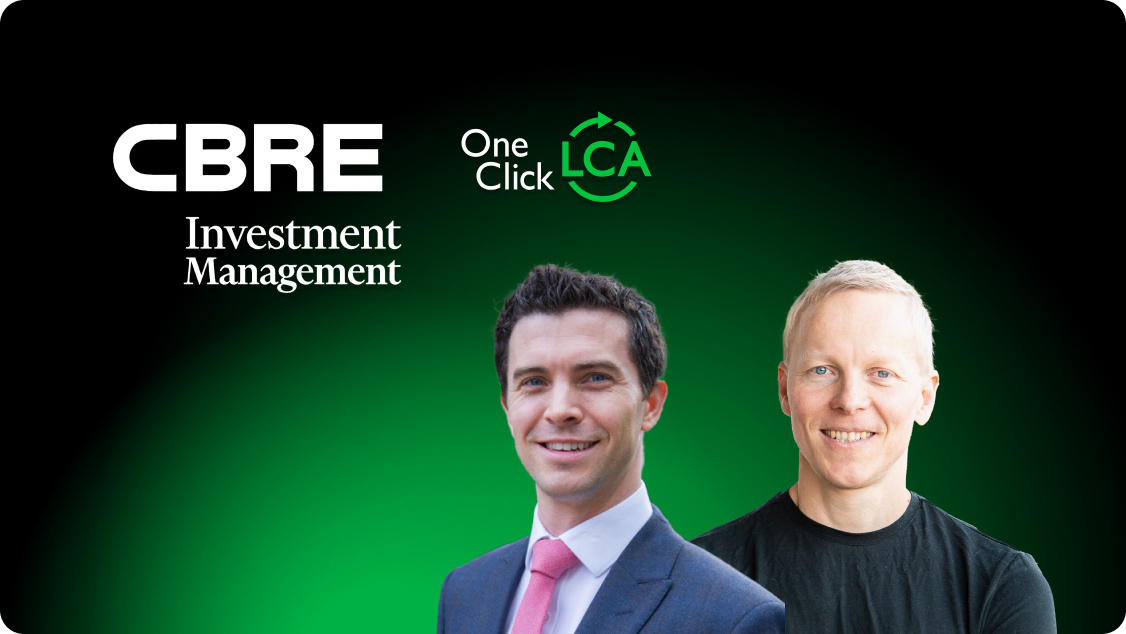
Key learnings from Panu Pasanen, Founder and CEO at One Click LCA, and Robbie Epsom, EMEA Head of Sustainability at CBRE Investment Management
Embodied carbon has become a focal point in discussions about sustainable construction and investment. Panu Pasanen and Robbie Epsom, leading voices in sustainability, have shared insightful views on the evolving role of embodied carbon in the economy and investment strategies, especially in the real estate and construction sectors.
Sustainability's impact on the economy: How far have we come?
Sustainability, once a peripheral concern in business and investment decisions, has now taken center stage, influencing major economic decisions across all sectors. The construction industry, in particular, has witnessed a significant shift in how embodied carbon impacts investment decisions and operational practices. Embodied carbon, the sum of all the greenhouse gas emissions associated with the production, transportation, and construction of building materials, has emerged as a critical measure of sustainability.
Historically, the lack of standardized methodologies for calculating and reporting embodied carbon limited its influence on economic activities. However, advancements in international standards and the development of sophisticated life-cycle assessment tools have provided the necessary framework for incorporating embodied carbon into economic evaluations. These developments have facilitated a broader understanding of how sustainability drives economic decisions, reshaping industries to prioritize greener, more sustainable outcomes.
Embodied carbon as critical investment criteria
Panu Pasanen and Robbie Epsom, leading voices in sustainability, share insightful views on the evolving role of embodied carbon in the economy and investment strategies.
CBRE's holistic approach to sustainability and what it is trying to achieve
CBRE Investment Management's strategy reflects a deep commitment to sustainability, which is articulated through its "four E's" framework: energy efficiency, electrification, energy procurement, and embodied carbon. This framework guides CBRE's approach to achieving net-zero emissions across its operations, emphasizing the importance of transitioning to zero-emission buildings. By focusing on these areas, CBRE aims to not only reduce its environmental impact but also enhance the sustainability of its asset portfolio, thereby delivering long-term value to its clients and stakeholders.
Embodied carbon plays a crucial role in this strategy, as it represents a significant portion of a building's overall carbon footprint. By systematically assessing and minimizing embodied carbon, CBRE is leading the way in transforming real estate into a more sustainable industry.
Embodied carbon sustainability goals that investors are including within their criteria
Investors are increasingly recognizing the importance of embodied carbon in their sustainability criteria. This shift is evidenced by a growing demand for detailed assessments of embodied carbon impacts before significant investments are made. Investors now expect transparency in how embodied carbon is measured and managed, seeking options and innovations that can demonstrably reduce the carbon footprint of construction projects.
The most forward-thinking investors are setting specific embodied carbon reduction targets for projects, requiring comprehensive life cycle assessments to ensure these targets are met. This proactive approach not only aligns with global sustainability goals but also mitigates financial risks associated with future regulatory changes that might penalize high-carbon investments.
The impact of embodied carbon on investment opportunities
Embodied carbon is increasingly viewed not just as a regulatory obligation but as a strategic component that can significantly influence investment decisions and market opportunities. As governments and regulatory bodies tighten emissions standards and introduce carbon taxes, the financial implications of ignoring embodied carbon become more pronounced. Investment in low-carbon solutions and technologies is becoming a critical factor in maintaining competitive advantage and securing market position.
Robust strategies for managing embodied carbon can enhance asset value, attract premium tenants, and secure funding under favorable terms. Conversely, failure to address embodied carbon adequately can lead to increased costs, reduced investment appeal, and potential regulatory penalties.
In conclusion, as the global economy continues to integrate sustainability into its core operations, the role of embodied carbon as a critical investment criterion will only grow in importance. Leaders like Panu Pasanen and Robbie Epsom are at the forefront of this transformation, guiding the construction and real estate sectors towards more sustainable and economically viable practices. Their insights underscore the vital need for the industry to adapt, innovate, and reimagine the future of construction through the lens of sustainability.
How One Click LCA can help you measure embodied carbon
One Click LCA is the world-leading end-to-end sustainability platform for construction and manufacturing. The software platform decarbonizes and drives sustainability across the construction value chain with scientific, easy-to-use, automated life-cycle assessment (LCA) and environmental product declarations (EPDs) to calculate and reduce the environmental impacts of building, infrastructure, and renovation projects and products. The platform also allows assessment of circularity, life-cycle cost, and biodiversity. One Click LCA is used in 170+ countries, including by blue-chip enterprises like Skanska, WSP, Foster+Partners, LafargeHolcim, ArcelorMittal, Arcadis, ARUP, Geberit, and Saint-Gobain, among others. It offers a unique global database with +250,000 LCA datasets; supports +80 standards and certifications, including LEED, BREEAM, GRESB and other national regulations; and seamlessly integrates with +20 of the most widely used BIM software tools, including Autodesk Revit®, Tekla Structures® and Bentley iTwin®. One Click LCA was founded in Helsinki, Finland in 2001, with a team of +200 people on all continents.
Carbon Experts Newsletter
Industry news & insights — straight to your inbox
Want to learn more?
Laura Drury • Sep 12 2025
Justyna Michalik-Minken • Jul 08 2025
Laura Drury • Feb 12 2025
Laura Drury • Mar 11 2025
